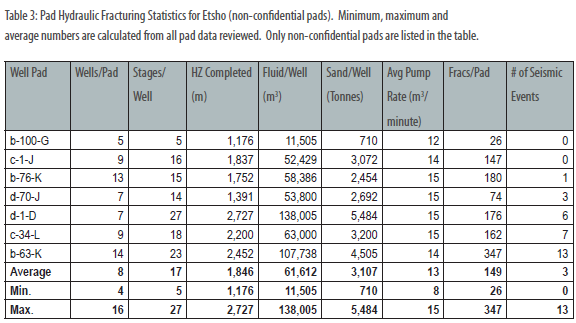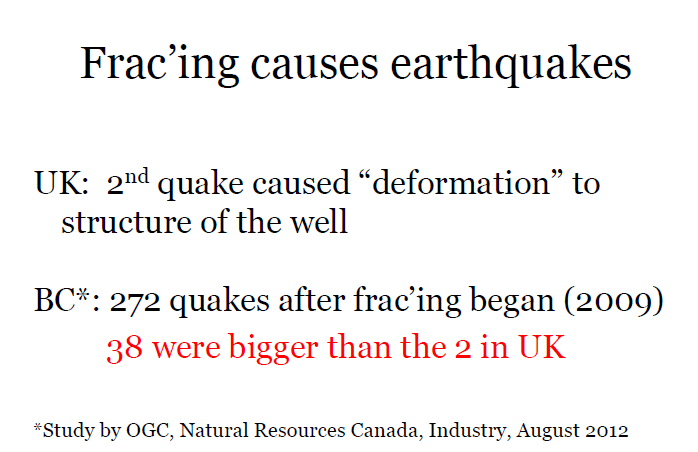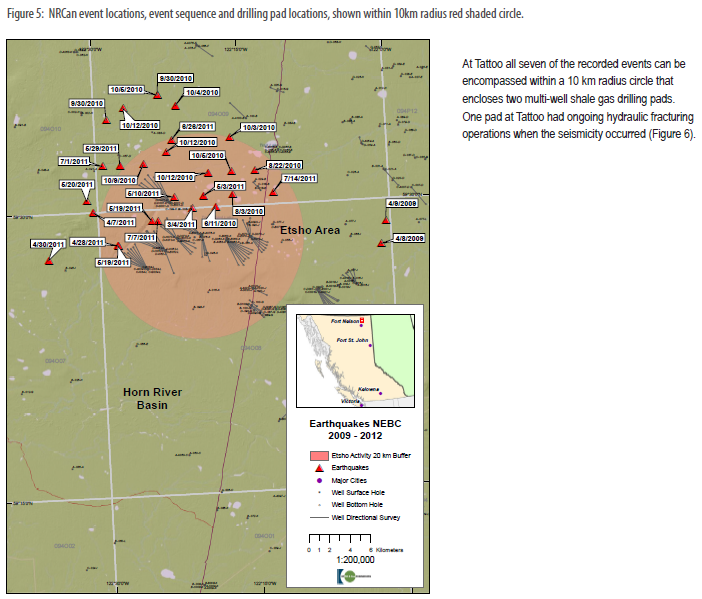Investigation of Observed Seismicity in the Horn River Basin by BC Oil and Gas Commission, August 2012
Between April 2009 and July 2011, 31 seismic events were recorded and located by NRCan in the Etsho area of the Horn River Basin in northeast British Columbia (Figure 1). Another seven events were recorded near the Tattoo area between Dec. 8 and Dec. 13, 2011. The observed events ranged in magnitude between 2.2 and 3.8 ML on the Richter scale as recorded by NRCan (Table 1). A search of the areas in the National Earthquake Database from 1985 to present shows no detected seismicity in the Horn River Basin prior to 2009.
…
Induced seismicity may be caused by numerous factors including slippage along fault planes, ground subsidence from collapse of solution mines and stress release from reservoir depletion. Fault movement can occur when previously stable subsurface stress conditions are altered. Human activities that can alter these stress conditions include fluid injection for secondary recovery in hydrocarbon reservoirs, injection of waste fluids into deep rock formations, withdrawal of hydrocarbons from reservoirs and geothermal energy operations involving deep fluid injection. Fluid injection may trigger induced seismicity. As fluid is injected, it flows into the existing pore system of the rock and into pre-existing fractures and faults. Across faults injection can increase pore pressure, counter-acting normal stress across the fault and may act to open an existing fault plane. This overcomes friction along the fault and can cause fault slippage.
In British Columbia, the only documented case of induced seismicity, linked to oil and gas activity, occurred in the Eagle Field area, approximately five km north of Fort St. John. Twenty-nine Richter magnitude 2.2 to 4.3 events were recorded from November 1984 to May 1994. Horner (Horner, 1994) used the Davis and Frohlich criteria (Davis and Frohlich, 1993) to conclude that the events were induced. High pressure fluid injection for secondary oil recovery was identified as a possible cause. High volume hydraulic fracturing was not employed in the area at that time.
In response to the Eagle Field incident, the regulator ordered the injection pressure be lowered. Since that time, reservoir waterflood and injection pressures within British Columbia are required to be maintained below levels capable of re-opening pre-existing fractures or faults. This requirement ensures the integrity of confinement boundaries and prevents fluid migration beyond the targeted formations.
Hydraulic fracturing operations in the Etsho area have been ongoing from February 2007 to late July 2011. During this period, 14 different drilling pads were used to drill over 90 wells with more than 1,600 hydraulic fracturing stage completion operations (Table 3). …

Recently, two international cases of induced seismicity have been documented linking hydraulic fracturing to seismic events. In the first case, Dr. C.J. de Pater and Dr. S. Baisch (de Pater and Baisch, 2011) directly tie hydraulic fracturing in the Bowland Shale near Blackpool, England to local seismicity. In the second case, Holland (Holland, 2011) suggests a relationship between hydraulic fracturing in Garvin County, Oklahoma and local seismicity. Other studies considered during the investigation include Shale Gas Extraction in the UK: A Review of Hydraulic Fracturing published by the Royal Academy of Engineering in June 2012 and Induced Seismicity Potential in Energy Technologies (Pre-Publication) by the US National Research Council.
…
As hydraulic fracturing fluids are injected into intact gas bearing shales, thousands of micro-seismicity events (approx -3.0 to 0.5 ML) are created as the rock is fractured. These events are caused by micro shear movement and
tensile fractures and by the re-opening of existing fractures and faults. … Only one event studied within this investigation was reported felt at surface. NRCan’s report on the May 19, 2011, 3.8 ML event indicates that the event was “felt by workers in (the) bush”.
…
Twenty-seven of the recorded Etsho events lie within a 10 km radius circle (Figure 5). Within this same circle are seven multi-lateral drilling pads. Five of these pads were conducting hydraulic fracturing operations when events occurred. At Tattoo all seven of the recorded events can be encompassed within a 10 km radius circle that encloses two multi-well shale gas drilling pads. One pad at Tattoo had ongoing hydraulic fracturing operations when the seismicity occurred (Figure 6).
Hydraulic fracturing and NRCan event timing were compared at 15 Etsho and Tattoo drilling pad sites. Nine pads had ongoing hydraulic fracturing operations when the NRCan events occurred (Figure 9). The other multi-well drilling pads in the Etsho area could not be linked to the NRCan events by location or timing. Eighteen magnitude 1.9 to 3.0 ML events were selected from dense array microseismic plots. These events were selected because they were located adjacent to hydraulic fracturing stages and could be connected to a single stage fluid injection with some confidence. Evidence strongly suggests that all events were triggered by fluid injection at adjacent stages. Figure 10 shows the time lapse from the beginning of the selected stage to the seismicity event time. One stage was linked to 3 events, four stages to 2 events each and 7 stages had one event. On average, stage start time to stop time was 5 ½ hours. Eight events occurred during stage operations. Seventeen events occurred within 17 ½ hours and all events had occurred within 24 hours of assigned stage start times. All stages along the d-G1-D (southwestern most) wellbore had 10,000 m3 total hydraulic fracturing fluid placed. For these stages, two injections of 5,000 m3 were placed at the same stage interval separated by about one hour. Eight of the events connected to the 11 stages graphed with 10,000 m3 total fluid placed, occurred prior to the second injection of 5,000 m3.
…
Two instances of wellbore deformation along horizontal sections were reported by one operator. These occurred over a short interval beginning at 3,011 m KB (Kelly Bushing) in the d-A1-D/94-O-9 well. In this instance, casing deformation was minor and did not hinder completion operations. At d-1-D/94-O-9, the deformation was encountered at 4,245 m KB and the casing distortion blocked completion efforts at 4,288 m KB. … This deformation was detected in July 2011.
…
Findings
1. The seismicity observed and reported by NRCan in the Horn River Basin between April 2009 and December 2011 was induced by fault movement resulting from injection of fluids during hydraulic fracturing.
…
Recommendations
…
Mitigation discussions with the operator will begin immediately. Mitigation steps taken will vary dependent on the risk posed by the events and may include enhanced data recovery for research purposes. An order to suspend hydraulic fracturing specific to the well under completion could be issued dependent on an evaluation of the previously stated criteria of event frequency, magnitude, ground motion, depth and proximity to populated areas. Operators will immediately suspend hydraulic fracturing operations for a well upon detection of a 4.0 ML or greater event.
…
Conclusion
Horn River Basin seismicity events, from 2009 to late 2011, were caused by fluid injection during hydraulic fracturing. All events occurred during or between hydraulic fracturing stage operations. [Emphasis added]
[Refer also to:

Slide from Ernst Presentations
Drillers face first class-action suit for triggered temblors
First Amended and Consolidated Class Action Complaint
Alberta Plays Catch-up on Frack Front, Regulator acknowledges water risks

